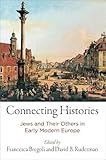Connecting Histories : Jews and Their Others in Early Modern Europe / ed. by Francesca Bregoli, David B. Ruderman.
Material type: TextSeries: Jewish Culture and ContextsPublisher: Philadelphia : University of Pennsylvania Press, [2019]Copyright date: ©2019Description: 1 online resource (328 p.) : 2 illusContent type:
TextSeries: Jewish Culture and ContextsPublisher: Philadelphia : University of Pennsylvania Press, [2019]Copyright date: ©2019Description: 1 online resource (328 p.) : 2 illusContent type: - 9780812296037
- Christianity and other religions -- Judaism -- History -- To 1500
- Jews -- Europe -- Identity -- History -- To 1500
- Jews -- Europe -- Social life and customs -- To 1500
- Judaism -- Relations -- Christianity -- History -- To 1500
- RELIGION / Judaism / History
- History
- Jewish Studies Medieval and Renaissance Studies
- Religion
- Religious Studies
- 940/.04924 23
- online - DeGruyter
| Item type | Current library | Call number | URL | Status | Notes | Barcode | |
|---|---|---|---|---|---|---|---|
 eBook
eBook
|
Biblioteca "Angelicum" Pont. Univ. S.Tommaso d'Aquino Nuvola online | online - DeGruyter (Browse shelf(Opens below)) | Online access | Not for loan (Accesso limitato) | Accesso per gli utenti autorizzati / Access for authorized users | (dgr)9780812296037 |
Frontmatter -- Contents -- Introduction. Connecting Histories: Jews and Their Others in Early Modern Europe -- Part I. Jews and Their Jewish Others -- Chapter 1. Connecting Stories? A Yiddish Folktale and Its Unpopular Hebrew Versions -- Chapter 2. “The Poor of Your City Come First”: Jewish Ritual and the Itinerant Poor in Early Modern Germany -- Chapter 3. A Sixteenth-Century Rabbi as a Published Author: The Early Editions of Rabbi Mordecai Jaffe’s Levushim -- Chapter 4. New Kabbalistic Genres and Their Readers in Early Modern Europe -- Chapter 5. The “Significant Other/s” and Their/Our Histories Moshe Idel -- Part II. Jews and Their Non-Jewish Others -- Chapter 6. On the Mysteries of the Law: A Conversation Between Pietro Aretino and Rabbi Elijah Menahem Ḥalfan -- Chapter 7. Praising the “Idolater”: A Poem for Christians by Rabbi Leon Modena -- Chapter 8. Crossing the Name Barrier: Non-Jewish Names in the Memoirs of Glikl bas Leib and in Early Modern Ashkenazic Jewish Culture -- Chapter 9. Pride and Punishment: Christians and Jews on the Meaning of the Jewish Presence in Worms -- Chapter 10. A Jewish Easter Lamb: Cultural Connection and Its Limits in a 1716 Prague Procession -- Chapter 11. Leibush the Lawless and His Border Tavern -- Part III. Conversos and Their Others -- Chapter 12. Alone Among the Sages of Sepharad?: Alfonso de Zamora and the Symbolic Capital of Converso Christian Hebraism in Spain After 1492 -- Chapter 13. From “Potential” and “Fuzzy” Jews to “Non-Jewish Jews”/“Jewish Non-Jews”: Conversos Living in Iberia and Early Modern Jewry -- Notes -- List of Contributors -- Index -- Acknowledgments
restricted access online access with authorization star
http://purl.org/coar/access_right/c_16ec
Whether forced by governmental decree, driven by persecution and economic distress, or seeking financial opportunity, the Jews of early modern Europe were extraordinarily mobile, experiencing both displacement and integration into new cultural, legal, and political settings. This, in turn, led to unprecedented modes of social mixing for Jews, especially for those living in urban areas, who frequently encountered Jews from different ethnic backgrounds and cultural orientations. Additionally, Jews formed social, economic, and intellectual bonds with mixed populations of Christians. While not necessarily effacing Jewish loyalties to local places, authorities, and customs, these connections and exposures to novel cultural settings created new allegiances as well as new challenges, resulting in constructive relations in some cases and provoking strife and controversy in others.The essays collected by Francesca Bregoli and David B. Ruderman in Connecting Histories show that while it is not possible to speak of a single, cohesive transregional Jewish culture in the early modern period, Jews experienced pockets of supra-local connections between West and East—for example, between Italy and Poland, Poland and the Holy Land, and western and eastern Ashkenaz—as well as increased exchanges between high and low culture. Special attention is devoted to the impact of the printing press and the strategies of representation and self-representation through which Jews forged connections in a world where their status as a tolerated minority was ambiguous and in constant need of renegotiation.Exploring the ways in which early modern Jews related to Jews from different backgrounds and to the non-Jews around them, Connecting Histories emphasizes not only the challenging nature and impact of these encounters but also the ambivalence experienced by Jews as they met their others.Contributors: Michela Andreatta, Francesca Bregoli, Joseph Davis, Jesús de Prado Plumed, Andrea Gondos, Rachel L. Greenblatt, Gershon David Hundert, Fabrizio Lelli, Moshe Idel, Debra Kaplan, Lucia Raspe, David B. Ruderman, Pavel Sládek, Claude B. Stuczynski, Rebekka Voß.
Mode of access: Internet via World Wide Web.
In English.
Description based on online resource; title from PDF title page (publisher's Web site, viewed 21. Jun 2021)


